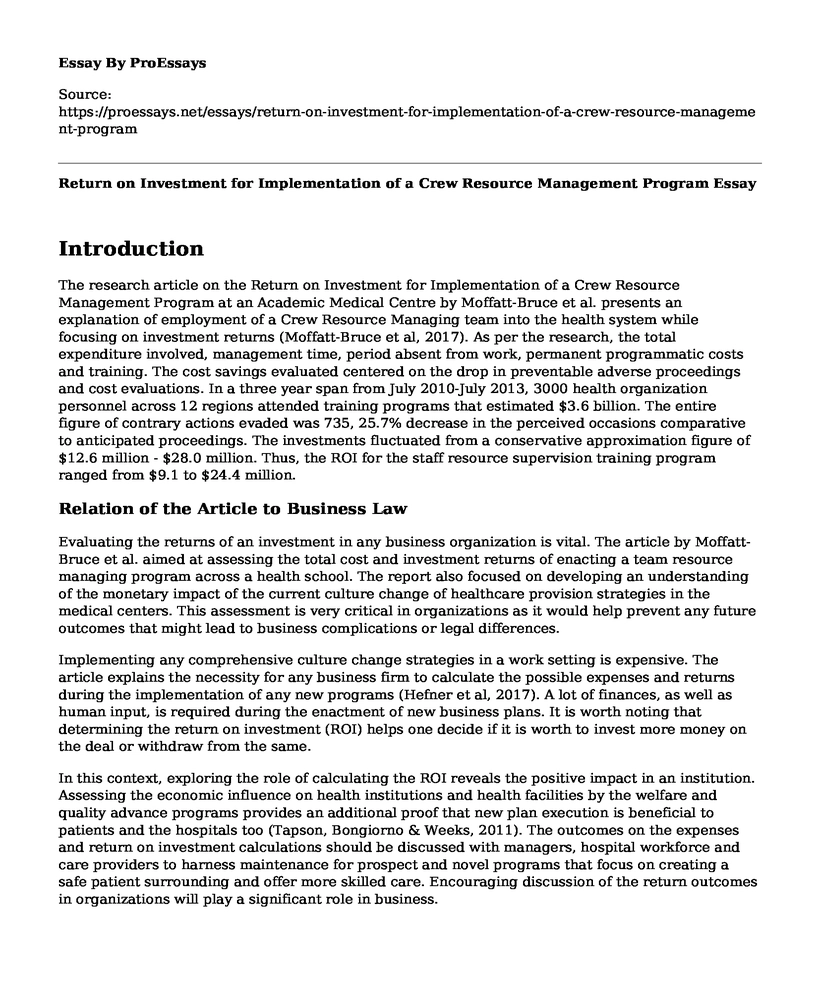Introduction
The research article on the Return on Investment for Implementation of a Crew Resource Management Program at an Academic Medical Centre by Moffatt-Bruce et al. presents an explanation of employment of a Crew Resource Managing team into the health system while focusing on investment returns (Moffatt-Bruce et al, 2017). As per the research, the total expenditure involved, management time, period absent from work, permanent programmatic costs and training. The cost savings evaluated centered on the drop in preventable adverse proceedings and cost evaluations. In a three year span from July 2010-July 2013, 3000 health organization personnel across 12 regions attended training programs that estimated $3.6 billion. The entire figure of contrary actions evaded was 735, 25.7% decrease in the perceived occasions comparative to anticipated proceedings. The investments fluctuated from a conservative approximation figure of $12.6 million - $28.0 million. Thus, the ROI for the staff resource supervision training program ranged from $9.1 to $24.4 million.
Relation of the Article to Business Law
Evaluating the returns of an investment in any business organization is vital. The article by Moffatt-Bruce et al. aimed at assessing the total cost and investment returns of enacting a team resource managing program across a health school. The report also focused on developing an understanding of the monetary impact of the current culture change of healthcare provision strategies in the medical centers. This assessment is very critical in organizations as it would help prevent any future outcomes that might lead to business complications or legal differences.
Implementing any comprehensive culture change strategies in a work setting is expensive. The article explains the necessity for any business firm to calculate the possible expenses and returns during the implementation of any new programs (Hefner et al, 2017). A lot of finances, as well as human input, is required during the enactment of new business plans. It is worth noting that determining the return on investment (ROI) helps one decide if it is worth to invest more money on the deal or withdraw from the same.
In this context, exploring the role of calculating the ROI reveals the positive impact in an institution. Assessing the economic influence on health institutions and health facilities by the welfare and quality advance programs provides an additional proof that new plan execution is beneficial to patients and the hospitals too (Tapson, Bongiorno & Weeks, 2011). The outcomes on the expenses and return on investment calculations should be discussed with managers, hospital workforce and care providers to harness maintenance for prospect and novel programs that focus on creating a safe patient surrounding and offer more skilled care. Encouraging discussion of the return outcomes in organizations will play a significant role in business.
Lessons Learned
Determining the financial ratios in business relates to calculating the ROI. Moffatt-Bruce and her research team illustrated the positive effect of revenue on investment by clearly showing how team training programs optimize the teamwork, organized medical groups like crew resource management (CRM), and communication are linked with positive hospital unit performance and care systems to account for the increasing figures of quality and care recording metrics (Siems, Cartron, Watson, McCarter, & Levin, 2017). The ROI calculations presented in the article indicated a substantial saving to the health center, and that the money can be enough for future reinvestments and related patient welfare development schemes. Therefore, conducting ROI assessments plays a significant role in any workstation.
References
Hefner, J. L., Hilligoss, B., Knupp, A., Bournique, J., Sullivan, J., Adkins, E., & Moffatt-Bruce, S. D. (2017). Cultural transformation after implementation of crew resource management: is it really possible?. American Journal of Medical Quality, 32(4), 384-390.
Moffatt-Bruce, S. D., Hefner, J. L., Mekhjian, H., McAlearney, J. S., Latimer, T., Ellison, C., & McAlearney, A. S. (2017). What is the return on investment for implementation of a crew resource management program at an academic medical center?. American Journal of Medical Quality, 32(1), 5-11.
Siems, A., Cartron, A., Watson, A., McCarter, R., & Levin, A. (2017). Improving pediatric rapid response team performance through crew resource management training of team leaders. Hospital pediatrics, hpeds-2016.
Tapson, V. F., Bongiorno Karcher, R., & Weeks, R. (2011). Crew resource management and VTE prophylaxis in surgery: a quality improvement initiative. American Journal of Medical Quality, 26(6), 423-432.
Cite this page
Return on Investment for Implementation of a Crew Resource Management Program. (2022, Jul 03). Retrieved from https://proessays.net/essays/return-on-investment-for-implementation-of-a-crew-resource-management-program
If you are the original author of this essay and no longer wish to have it published on the ProEssays website, please click below to request its removal:
- Risks in the Banking Industry
- Analysis of New Methods for the Diagnosis of the Intellectual Level of Subnormal's
- Reflection on How the Health Care Course Has Played a Role in Goal Achievement
- Essay Example on Smoking Cessation Program: A Public Health Success
- Essay on 5-Year Plan: Essential for Health Care Professionals
- Essay on Satyam Scandal: Ramalinga Raju's Fraudulent Misrepresentation of Company Funds
- Paper Sample on Elderly Home Care: Inpatient Education for Safety







